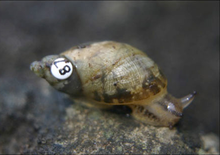
Back Novisuccinea chittenangoensis Bulgarian Novisuccinea chittenangoensis CEB Succinea chittenangoensis Spanish Succinea chittenangoensis Portuguese Novisuccinea chittenangoensis Swedish Novisuccinea chittenangoensis WAR 奇特南戈琥珀螺 Chinese
| Chittenango ovate amber snail | |
|---|---|

| |
| Right side view of Novisuccinea chittenangoensis. The snail is marked with a number for monitoring the population. | |
| Scientific classification | |
| Domain: | Eukaryota |
| Kingdom: | Animalia |
| Phylum: | Mollusca |
| Class: | Gastropoda |
| Subclass: | Heterobranchia |
| Order: | Stylommatophora |
| Family: | Succineidae |
| Genus: | Novisuccinea |
| Species: | N. chittenangoensis
|
| Binomial name | |
| Novisuccinea chittenangoensis | |
| Synonyms | |
| |
The Chittenango ovate amber snail (Novisuccinea chittenangoensis) is a species of small air-breathing land snail in the family Succineidae, the amber snails. This species was discovered in 1905, and was reported three years later as a subspecies of the oval ambersnail, Succinea ovalis. Several taxonomic reviews took place in the subsequent decades until the end of the 1980s, when the Chittenango ovate amber snail was finally judged to be a distinct species based on chemical and morphological data.
The Chittenango ovate amber snail is endemic to the Chittenango area of Madison County, New York, United States. There is only one population, located at Chittenango Falls State Park in central New York, even though it was believed to have a broader range previously; based on fossil records, some authors argue that the distribution of this species may have been much wider in the past. In opposition to this, other authors argue that it is impossible to identify this species based on fossil records, because they only allow for examination of shell features. Shell features of species in this particular family of snails are usually not very distinctive.
Novisuccinea chittenangoensis has a small (an average of 20.9 mm in length in adult individuals), delicate, ovate shell of 3¼ whorls, with deep sutures. The shell is almost translucent, and varies in color from a chalky pale yellow to white, with a glossy surface. Several internal organs of the animal can be distinguished through the shell's outer surface. The visible soft parts of the animal are of a pale subtranslucent yellow color, with different markings during distinct stages of development.
Studies on the ecology of the Chittenango ovate amber snail are fairly recent. It is an herbivorous species which lives in the fresh spray zone of the Chittenango Falls, in partially sunlit areas with lush herbaceous growth. Several parameters appear to be influential in its habitat selection, namely humidity, substrate, temperature, vegetation, and water quality. Novisuccinea chittenangoensis is a hermaphroditic species, and its mating season is from May through July. It lays egg clusters, each one containing an average of 8 to 14 eggs, at the base of plants, under matted vegetation, or in loose, wet soil. Maturity is reached in five to eight months, and its life span is roughly 2.5 years. Some of its predators include insects, amphibians, mammals, birds, and occasionally other snails.
Since the time of its discovery in 1905, there have been many attempts to estimate the population size of this species. Results varied greatly, but the more recent ones suggest a very reduced number of individuals. This coupled with a very restricted distribution have led to the listing of Novisuccinea chittenangoensis as an endangered or threatened species. Humans frequently invade its habitat, though such disturbances have been greatly reduced by preventive measures. Recent efforts in conservation include perpetuating the extant population at a baseline size as well as maintaining captive populations.
- ^ Mollusc Specialist Group (1996). Succinea chittenangoensis.2006 IUCN Red List of Threatened Species Archived June 27, 2014, at the Wayback Machine. Accessed 7 August 2007.
- ^ "NatureServe Explorer 2.0". explorer.natureserve.org. Retrieved 2 May 2022.
- ^ Pilsbry H. A. (1908). "Notes on Succinea ovalis Say and Succinea obliqua Say". Proceedings of the Academy of Natural Sciences of Philadelphia 60: 45-51 + pl. 7, figures 1-8.
© MMXXIII Rich X Search. We shall prevail. All rights reserved. Rich X Search

